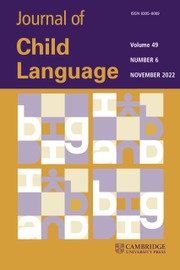Article contents
Nursery rhymes, phonological skills and reading*
Published online by Cambridge University Press: 17 February 2009
Abstract
Nursery rhymes are an almost universal part of young English-speaking children's lives. We have already established that there are strong links between children's early knowledge of nursery rhymes at 3;3 and their developing phonological skills over the next year and a quarter. Since such skills are known to be related to children's success in learning to read, this result suggests the hypothesis that acquaintance with nursery rhymes might also affect children's reading. We now report longitudinal data from a group of 64 children from the age of 3;4 to 6;3 which support this hypothesis. There is a strong relation between early knowledge of nursery rhymes and success in reading and spelling over the next three years even after differences in social background, I.Q and the children's phonological skills at the start of the project are taken into account. This raises the question of how nursery rhymes have such an effect. Our answer is that knowledge of nursery rhymes enhances children's phonological sensitivity which in turn helps them to learn to read. This paper presents further analyses which support the idea of this path from nursery rhymes to reading. Nursery rhymes are related to the child's subsequent sensitivity to rhyme and phonemes. Moreover the connection between knowledge of nursery rhymes and reading and spelling ability disappears when controls are made for differences in these subsequent phonological skills.
Information
- Type
- Articles
- Information
- Copyright
- Copyright © Cambridge University Press 1989
Footnotes
This research is supported by a research Grant from the Medical Research Council. We are also grateful for the help of Marie Clay, Chris Pratt and Usha Goswami, all of whom read and commented on an earlier version of this paper. We should like to thank Kathryn Rhodes for her part in helping to collect data during the first year of our project. We are very grateful to the teachers and staff of several local Primary and First schools for letting us visit the children in our project at school. The schools are: Bernwood, Botley, Church Cowley, East Oxford, Greycoates, Headington Quarry, Kennington, Larkrise, New Marston, Orchard Meadow, Our Lady's, Pegasus, St Andrews, St Ebbes, St Francis, St John Fisher, St Josephs, St Mary and St John, St Nicholas, St Thomas More, Sandhills, Speedwell, Speenhamland, The Crescent, The Queen's Dyke, Windmill, Wolvercote and Wood Farm.
References
REFERENCES
- 213
- Cited by

